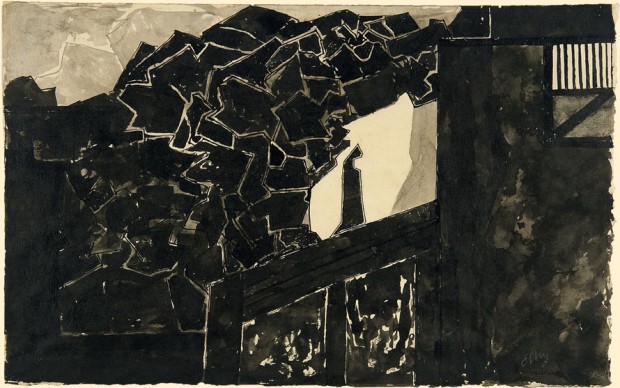
Rabindranath Tagore, “Untitled (Architectural setting with a silhouetted figure),” ink on paper, 1929
Asia Society
725 Park Ave. at 70th St.
Tuesday – Sunday, $10, 11:00 am – 6:00 pm
212-288-6400
www.asiasociety.org
Although Rabindranath Tagore might be most well known for being the first non-European to win the Nobel Prize in Literature, having given Mohandas Gandhi the name Mahatma, composing the national anthems of both Bangladesh and India (among more than two thousand other songs), and being a subject in Philip Glass’s epic opera Satyagraha, he also became a painter in his later years, beginning at the age of sixty. Several dozen of his paintings and drawings are on view at Asia Society through December 31 in the fascinating exhibition “Rabindranath Tagore: The Last Harvest.” Tagore once said, “Love is kindred to art, it is inexplicable. Duty can be measured by the degree of its benefit, utility by the profit and power it may bring, but art by nothing but itself. There are other factors of life which are visitors that come and go. Art is the guest that comes and remains. The others may be important, but art is inevitable.” Tagore’s works are filled with love, focusing on the human body, nature, animals, portraiture, and the environment, together forming a kind of captivating visual poetry. The exhibit, which runs through December 31, is supplemented with biographical information, music, and a documentary on Tagore made by India’s greatest filmmaker, Satyajit Ray. Also on view through the end of the year is “U-Ram Choe: In Focus,” a large kinetic sculpture of a fantastical creature the Korean artist calls “Custos Cavum.” Composed of steel, stainless steel, brass, aluminum, resin, CPUs, and motors, it at times seems to come alive, its myriad antenna-like extremities rising and twisting, its body appearing to breathe in and out. The excellent triumvirate of exhibitions at Asia Society is completed by the lightweight “Sarah Sze: Infinite Line,” but we don’t mean that in a negative way. The Boston-born, New York City-based artist, whose “Corner Plot” was installed at the Scholars’ Gate entrance to Central Park in 2006, uses paper, string, tape, twigs, mirrors, and found objects galore in creating fragile alternate universes built on memory. “I am interested in an object or image that plays with the state of its own existence,” she says. “In both drawing and sculpture I’m interested in the depiction of gravity and weightlessness as both an operative and a disorienting force.” Be careful where you walk when making your way around Sze’s engaging world, which continues at Asia Society through March 25.